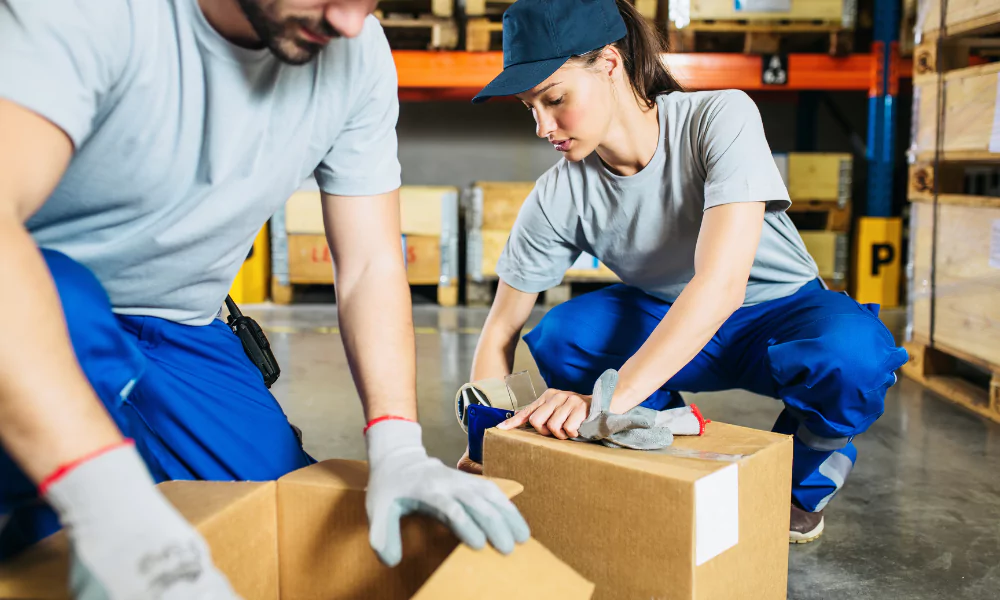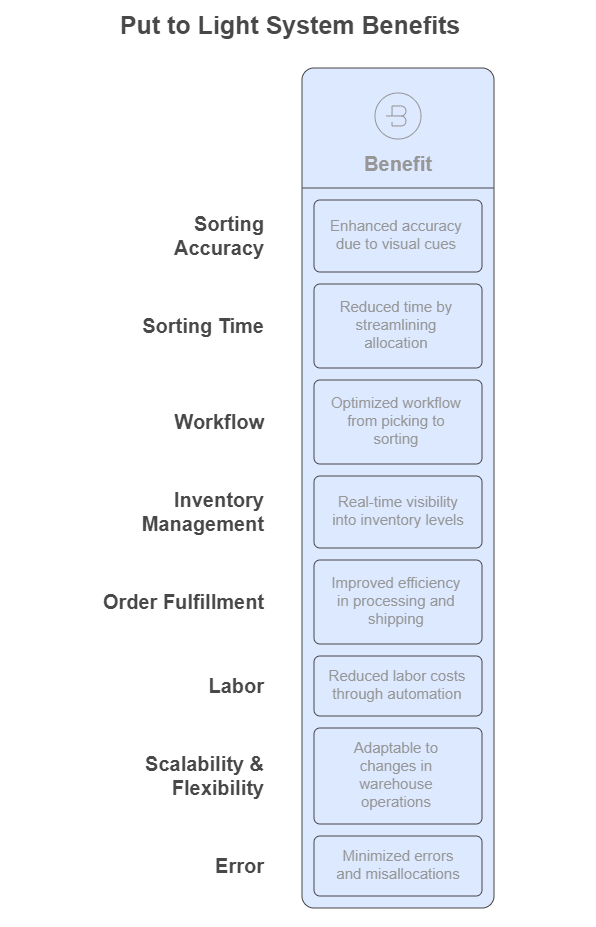
Sorting items in heavy containers is done using automated solutions like Put Light. Similar to a pick-to-light system, it replenishes stock and maintains inventory management. Designed to maximise efficiency, they reduce the errors in order processing.
What is the technology? How does it work? Let’s explore put-to-light technology in detail.
What are Put-Light Systems?
The main idea is to use LED light devices to guide operators in picking, process, and storing orders. A warehouse has hundreds of drawers, containers, and shelves and the core operation of a put-light system is shipping agile and error-free orders.
They are connected to the Warehouse Management System(WMS), coordinating the light display and optimising the working of operators. To speed up the supply of stock, conveyor belts can be installed along with the put light systems.
How Put Light Technology Works
Among the significant warehouse order-picking methods, the put-to-light technology employs light rays to direct workers to specific containers or zones. Here is an overview of all the important components.
- Pick Modules – These are the shelving racks to store the products.
- Containers – These are the important bins to store the items being picked.
- Control System – It is the software or hardware managing the PTL( Put-To-Light) system.
- Lights – Each location is equipped with a lighting module.
The Process

- Order Stacking – When a large order is placed, it is broken down into individual stock units and picked from the warehouse.
- Batching: Orders are often grouped into batches based on geographic location, delivery time, or product type. This batching helps optimize picking routes and maximize efficiency.
- Picking: Once orders are batched, workers or automated systems move through the warehouse to pick up the required items. In some cases, the order-picking process is done at once, while in others, it may involve picking individual items to fulfil multiple orders simultaneously.
- Tote or Carton Assignment: As items are picked, they are placed into totes or cartons. Each tote or carton is assigned a unique identifier, such as a barcode or RFID tag, corresponding to the order or batch it belongs to.
- Put-to-Light Stations: These stations are located at various points throughout the warehouse, typically near packing or shipping areas. Each station consists of a series of compartments or bins, each equipped with a light and a display screen.
- Sorting and Allocation: Once items are picked and placed into totes or cartons, they are transported to the appropriate put-to-light station. At these stations, the totes or cartons are scanned, and the system determines which items need to be placed in each compartment or bin based on the orders being fulfilled.
- Guided Putaway: The lights above the compartments or bins indicate where each item should be placed. Workers follow these visual cues to quickly and accurately allocate items to their designated locations.
- Confirmation: After placing each item in its assigned location, workers typically confirm the action by pressing a button or scanning a barcode. This confirmation updates the system in real time, ensuring accurate inventory tracking.
- Quality Control: Put-to-light systems often incorporate quality control measures to verify that the correct items have been placed in the correct locations. This may involve additional scanning or visual checks to ensure accuracy.
- Final Processing: Once all items have been allocated to their respective locations, the totes or cartons are ready for the next stage of processing, such as packing, labelling, or shipping.
Next, let’s understand the major differences between put-to-light and pick-to-light.
Comparing Put to Light and Pick to Light Systems
| Put to Light | Pick to Light |
| 1. They are used to allocate the picked items. | 1. They guide workers during the picking process. |
| 2. Allocates picked items to shipping containers. | 2. It directs pickers to the allocated items. |
| 3. Enhances sorting efficiency. | 3. Reduces picking errors. |
| 4. Lights/displays indicate allocation systems | 4. Lights/displays show item quantities. |
Next, let’s shed light on the amazing benefits of put-to-light systems.
Benefits of Implementing a Put to Light System

1) Enhanced Sorting Accuracy
Put-to-light systems significantly improve sorting accuracy by providing visual cues to guide workers in allocating picked items to their respective orders or shipping containers. The lights or displays at put-to-light stations indicate precisely where each item should be placed, reducing the likelihood of errors and misplacements.
2) Reduced Sorting Time
By guiding workers through the allocation process and eliminating the need for manual sorting decisions, put-to-light systems streamline sorting operations. Workers can quickly and efficiently allocate picked items to their designated locations, minimising sorting time and expediting the order fulfilment process.
3) Optimized Workflow
Put-to-light systems help optimise warehouse workflow by facilitating the seamless transition from the picking to the sorting phase. After items are picked, they are transported to put-to-light stations where workers can easily allocate them to their respective orders or shipping containers, ensuring a smooth and efficient workflow.
4) Real-Time Inventory Management
Put-to-light systems provide real-time visibility into inventory levels and order status. As workers allocate picked items to their designated locations, the system updates inventory records in real time, enabling accurate inventory management and ensuring that stock levels are always up-to-date.
5) Improved Order Fulfillment Efficiency
By minimising sorting errors, reducing sorting time, and optimising workflow, put-to-light systems contribute to overall order fulfilment efficiency. Processing and shipping orders more quickly and accurately leads to improved customer satisfaction and retention.
6) Reduction of Labour
This systems help reduce labour costs by automating and streamlining the sorting process. With visual cues guiding workers through the allocation process, fewer labour hours are required for sorting activities, allowing warehouse resources to be allocated more efficiently.
7) Scalability and Flexibility
These systems are highly scalable and can be easily adapted to accommodate changes in warehouse operations, such as fluctuations in order volume or SKU diversity. They can also be integrated with other warehouse technologies and systems to further enhance efficiency and flexibility.
8) Error Reduction
By providing clear visual cues and instructions, this systems minimise the potential for sorting errors and misallocations. Workers can easily identify where each item should be placed, reducing the risk of shipping incorrect items or orders, minimizing costly returns, and preventing customer dissatisfaction.
Wrapping things up, let’s delve into the FAQs section of this technology.
Conclusion
To conclude, an efficient put light system is a single piece of the warehousing jigsaw puzzle. It binds together all the equipment for smoother operations leading to enhanced order fulfilment. The sorting of products into individual orders eliminates bottlenecks, fuelling customer satisfaction.
Are you in need of an efficient logistical solution? Get in touch with Qodenext to simplify your supply chain management.
FAQs – Put Light System
1. What exactly is a put-to-light system in simple terms?
A put-to-light system uses lights to tell warehouse workers where to place items. It’s like a glowing guide that shows which bin or shelf each item belongs to, making sorting faster and more accurate.
2. How is put-to-light different from pick-to-light?
Put-to-light helps workers place items into the right bins for different orders. Pick-to-light helps workers pick items from shelves to fulfill orders. One guides placing, the other guides picking.
3. Who should use a put-to-light system?
Any business with high volumes of orders—like ecommerce, retail, or third-party logistics providers—can benefit from put-to-light to improve speed, reduce errors, and streamline sorting.
4. How does put-to-light technology help reduce errors?
The system lights up the exact spot where an item needs to go. This simple visual cue prevents mistakes like placing items in the wrong order bin.
5. Can small warehouses use put-to-light systems too?
Yes! Put-to-light systems can be scaled to fit small or large operations. Even small warehouses can benefit from faster sorting and fewer order mix-ups.
6. Is put-to-light technology hard to use or install?
Not at all. It’s designed to be user-friendly and easy to train staff on. Installation is straightforward, and it can be integrated with your warehouse management software.
7. Can put-to-light systems work with conveyor belts?
Absolutely. Put-to-light systems often work alongside conveyor belts to move items efficiently through sorting and packing areas, speeding up the entire order fulfillment process.
8. How does a put-to-light system help with real-time inventory management?
When workers place items and confirm it with a button or scan, the system instantly updates inventory data—so you always know what’s in stock and what’s been shipped.
9. Does using put-to-light really save on labor costs?
Yes. Because it guides workers clearly and reduces sorting time, you need fewer people to handle the same amount of work. This leads to lower labor costs and better use of your team.
10. What are the long-term benefits of using a put-to-light system?
Over time, it boosts accuracy, speeds up order fulfillment, reduces returns due to errors, and makes warehouse operations smoother. It also grows with your business, making it a smart long-term investment.






